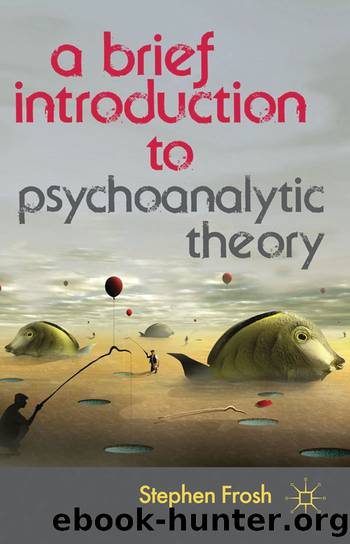A Brief Introduction to Psychoanalytic Theory by Stephen Frosh

Author:Stephen Frosh
Language: eng
Format: epub
ISBN: 9781137148858
Publisher: Palgrave Macmillan Ltd.
Relational thinking
Perhaps two statements define the object relational stance most clearly. One comes from the Scottish psychoanalyst Ronald Fairbairn (1944, p. 70): libido is primarily object-seeking (rather than pleasure-seeking, as in the classic theory), and ... it is to disturbances in the object-relationships of the developing ego that we must look for the ultimate origin of all psychopathological conditions.’ The impulse towards relationships is thus ‘hardwired’ into the infant, and it is frustrations and disruptions of that impulse that produce psychological difficulties. The second quote comes from Donald Winnicott, whose highly influential work was briefly described in Chapter 10. Winnicott (1975, p. 99) writes, ‘There is no such thing as a baby ... if you show me a baby you certainly show me also someone caring for the baby, or at least a pram with someone’s eyes and ears glued to it. One sees a “nursing couple”.’ While this might seem an overly concrete way of considering the earliest relationships of life, with strongly middle-class norms attached to it, it succinctly makes the point that humans are social beings, born into relationships of mutual dependency, and that the way these relationships work out is a powerful influence on the psychological make-up of everyone. It is not that people are born separate and then have to forge links with others. It is rather that we are born in the context of intimate, dependent relationships and the nature of these relationships is crucial in determining what our emotional lives will be like.
Object relations theory, and relational thinking generally, thus proposes that the human individual’s basic reality is expressed in her or his relationships. These are organized to meet fundamental needs that are very different from the needs that are the stuff of Freudian drive theory, being concerned instead with the interpersonal conditions required for healthy psychological development. Greenberg and Mitchell (1983, p. 198), for example, list the basic ‘needs’ implicit in Winnicott’s theory as including ‘an initially perfectly responsive facilitation of [the infant’s] needs and gestures; a nonintrusive “holding” and mirroring environment throughout quiescent states’, and so on – no mention here of feeding or the gratification of any sexual impulse, the usual bases for a biological drive theory of human social development. Fairbairn thought that at the start of life a relationship-seeking ego constitutes the whole of the infant’s mental structure. Consequently, it is not necessary to assume the existence of an ‘id’ as a separate psychic structure which contains a pool of impulses that fuel psychological functioning. Instead, the psyche is thought initially to be a unity, a total ego, which has the potential to develop into a coherent and integrated personal self. Psychic splitting is a secondary phenomenon, a derivative of something else, and signifies a distortion of ideal development. Fairbairn’s claim is that the child is a whole being from the start of life and would naturally remain whole however much might alter during development, except that various frustrations get in the way. In Guntrip’s (1973, p. 93)
Download
This site does not store any files on its server. We only index and link to content provided by other sites. Please contact the content providers to delete copyright contents if any and email us, we'll remove relevant links or contents immediately.
Bioenergetica by Alexander Lowen(1414)
The Child in You by Stefanie Stahl(1190)
No Bad Parts by Richard C. Schwartz(1159)
Noise: A Flaw in Human Judgment by Sunstein Cass R. & Sibony Olivier & Kahneman Daniel(1144)
The Data Detective by Tim Harford(1077)
Chatter by Ethan Kross(1014)
The Science of Rapid Skill Acquisition by Peter Hollins(864)
The Quantum Psychiatrist: From Zero to Zen Using Evidence-Based Solutions Beyond Medication and Therapy by Biswas Dona(826)
Freedom by Sebastian Junger(803)
The Montessori Baby by Simone Davies(779)
Maps of Meaning: The Architecture of Belief by Jordan B. Peterson(699)
The Science of Self-Learning: How to Teach Yourself Anything, Learn More in Less Time, and Direct Your Own Education (Learning how to Learn Book 1) by Peter Hollins(681)
Evolution Gone Wrong: The Curious Reasons Why Our Bodies Work by Alex Bezzerides(663)
Sadomasochism and the BDSM Community in the United States by Stephen K. Stein(642)
Anxiety For Dummies by Charles H. Elliott & Laura L. Smith(626)
Why Sex Doesn't Matter by Olivia Fane(615)
Disconnected by thomas Kersting(609)
Jung - The Key Ideas: Teach Yourself (TY Philosophy) by Ruth Snowden(586)
The Mechanics of Passions: Brain, Behaviour, and Society by Alain Ehrenberg(583)
